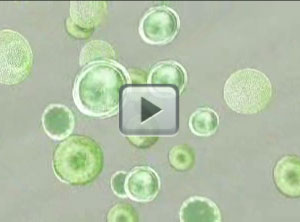Education: Gallery
Phytoplankton & the Ocean "Carbon Sink" (00:01:32)
[08-Oct-09] At the ocean's surface, carbon dioxide from the atmosphere dissolves into the water. Tiny marine plants called phytoplankton use this carbon dioxide for photosynthesis. Phytoplankton are the base of the marine food web. After animals eat the plants, they breathe out the carbon or pass it up the food chain. Sometimes phytoplankton die, decompose, and are recycled in the surface waters. Phytoplankton can also sink to the bottom of the ocean, where they become buried in marine sediment.Over long time scales, this process has made the ocean floor the largest reservoir of carbon on the planet. Most of the ocean's nutrients are in cold, deep water. In a process called upwelling, currents bring nutrients and carbon up to the surface. Carbon can then be released as a gas back into the atmosphere, continuing the carbon cycle. By cycling huge amounts of carbon, the ocean helps regulate climate.
Scott Doney: "So when you think of climate, you don't often think of the ocean. With climate - you think of, is it going to be hotter this year, or is it going to be colder this year? But the oceans are actually a great regulator, a controller of Earth's climate. And they even are controlling how much carbon is in the atmosphere, which can slow down how quickly climate change is occurring." View full movie here. Credit: NASA/Goddard Space Flight Center.
Original Movie: https://svs.gsfc.nasa.gov/vis/a010000/a010400/a010498/

